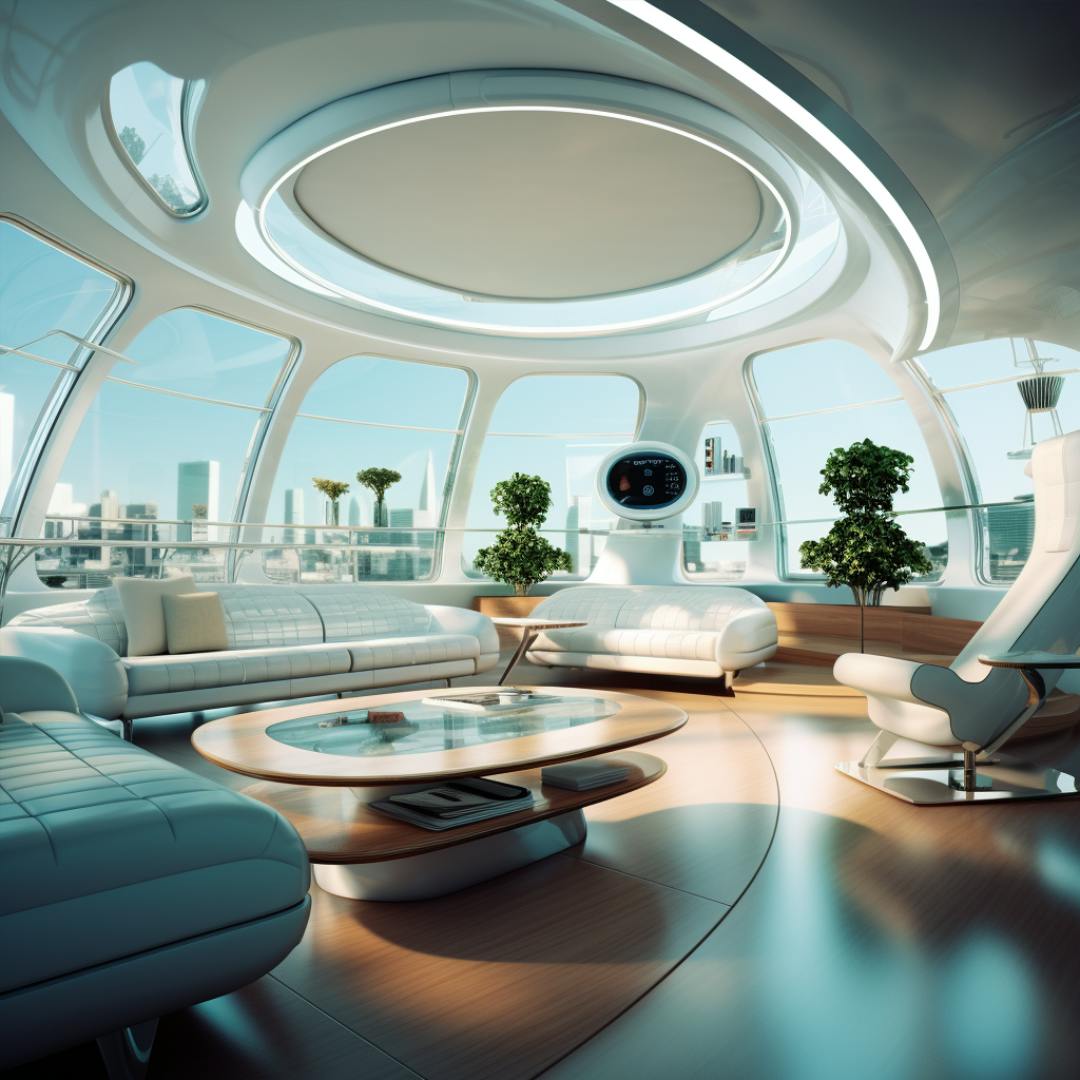Interactive fabrics will be in every on-trend living room in just a few years, but we’ll have to wait a few more decades for gravity-defying furniture and “multi-dimensional decor” – according to an artificial intelligence that was tasked with forecasting far-future design trends…
Luxury sheepskin home company, Jacobs & Dalton, used an AI text generator to predict what might be popular in the next 100 years, based on past trends.
The AI model was fed data from design trends from the past century, meaning the predictions are grounded in historical patterns and current trajectories.
The results are “a captivating blend of creativity and foresight,” declares Jacobs & Dalton. They feature some sci-fi level technological advances (ranging from gravity defying designs to living textiles that can provide air purification and self-repair), alongside some retro-themed handicrafts with a techno twist…
Here’s how AI believes the next century of home decor will look:
2030s: Sensory Exploration
- Interactive Fabrics: Textiles that change colour or texture in response to touch or environmental factors.
- Haptic Feedback Cushions: Pillows and cushions that provide tactile feedback or massage.
- Aromatherapeutic Textiles: Fabrics infused with scents that release over time or when activated.

2040s: Space Age Revival
- Astro Design: With potential human settlements on Mars or the Moon, there might be a renewed interest in space-themed interiors.
- Self-Sustaining Interiors: Designs that incorporate renewable energy sources, water purification systems, and indoor farming.
- Minimal Waste: A focus on designs that reduce waste, with furniture and items that are built to last and can be easily recycled or repurposed.

2050s: Bioluminescent & Living Textiles
- Glowing Fabrics: Textiles that naturally glow in the dark, either through technology or bioengineering.
- Living Curtains: Curtains made of living plants or moss, providing air purification.
- Self-Repairing Fabrics: Materials that can mend themselves when torn or damaged.
- Sensory Environments: Spaces designed to enhance or alter human senses, offering immersive experiences.

2060s: Climate Responsive
- Heat-Adaptive: Fabrics that cool down or warm up based on ambient temperatures.
- Water-Harvesting Drapes: Curtains that can extract and store moisture from the air.
- Air-Purifying Upholstery: Furniture coverings that actively clean the air.

2070s: Neo-Traditionalism
- Historical Revival: A nostalgic return to designs from the past, reinterpreted with modern materials and technologies.
- Digital Vintage: Patterns from the past, but with digital enhancements like animated motifs.
- Craftsmanship Renaissance: A renewed appreciation for handcrafted, artisanal items.
- Local Materials: A focus on using materials sourced locally, celebrating regional design aesthetics.

2080s: Multi-Dimensional Decor
- AI-Driven Interiors: Spaces designed by AI for efficiency, aesthetics, and function.
- Holographic Decor: The use of holograms for decorative purposes, allowing for ever-changing interiors.
- Mood-Responsive Patterns: Patterns that shift and change based on the mood of the room’s occupants.
- Floating Fabrics: Textiles that can levitate, creating dynamic, floating decor.

2090s: Earth 2.0
- Earth-Inspired: With potential exploration or colonisation of other planets, there might be a trend to recreate “Earth-like” interiors in off-world habitats.
- Gravity-Defying Design: Furniture and interiors that play with gravity or lack thereof.
- Multi-Planetary Fusion: A blend of design aesthetics inspired by different planets or celestial bodies.

2100s: Elemental Balance
- Neo-Minimalism: A movement back to simple, uncluttered spaces as a counter-response to a century of rapid change.
- Earth & Sky Fusion: Designs that blend earthy textures with airy patterns.
- Water-Inspired Flow: Fluid, wavy patterns inspired by oceans, rivers, and rain.
- Fire Motifs: Warm, glowing patterns and textures reminiscent of flames and embers.

2110s: Neo-Nature & Digital Fusion
- Digital-Natural Hybrids: Fabrics that blend organic textures with digital interfaces.
- Responsive Ecosystem Textiles: Fabrics that interact with other elements in the room, creating a harmonious ecosystem. For instance, a rug that “communicates” with the lighting to adjust its ambiance based on the rug’s patterns.
- Deep Sea Inspirations: As we explore deeper into our oceans, textiles inspired by the mysterious creatures and landscapes of the deep sea, with bioluminescent patterns and iridescent finishes.

2120s: Animalia Reverie
- Mimicry Materials: Fabrics that mimic the adaptive camouflage abilities of animals like chameleons or cuttlefish. Imagine a cushion that changes its pattern based on its surroundings or your mood.
- Avian Airiness: Lightweight, airy fabrics inspired by bird feathers. These could be used in draperies or throws that seem to float in the breeze, capturing the essence of flight.
- Sonic Resonance: Drawing inspiration from animals that communicate through unique sounds, like whales or birds. These fabrics could produce soothing sounds when touched or interacted with, creating a multisensory experience.

Gallery: Next-century interior, according to an AI
In this article
Topics
In PicturesMain image: 2110s












